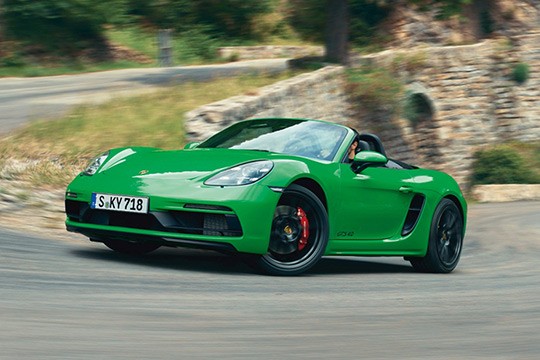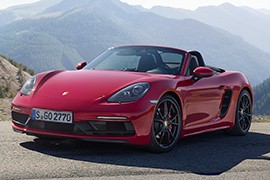PORSCHE 718 Boxster GTS Models/Series Timeline, Specifications & Photos
First production year: 2017
Engines: Gasoline
Body style: Convertible (spider/spyder, cabrio/cabriolet, drop/open/soft top)
Porsche decided to give a boost to the 718 Boxster range in 2019 when it introduced the GTS 4.0 version, and the new open-top vehicle was a true competitor for its bigger and more notorious brother, the 911.
When the German sports car maker launched the original Boxster back in the ‘90s, it did it to provide a more affordable but still performant sports car. That model had a 2.0-liter engine that couldn’t provide enough performance, and soon, Porsche increased the displacement to a 2.5-liter powerplant. It was close, but no cigar. Later evolutions of the model started to make customers think of the Boxster not as a cheaper 911 but as a different sportscar, and the GTS 4.0 from the 718 Boxster’s fourth generation was the kind of go-fast vehicle that customers waited for.
The 2019 GTS 4.0 version looked very similar to its 2.0-liter turbocharged sibling, but there were some subtle differences between them. Just like the 2016 model, it featured a flat nose with a lower bumper that sported a broad air intake divided into three parts. The central one featured an A-shape and was flanked by side scoops that wore a single horizontal slat, unlike the lesser-powered 2.0-liter version that had three. From their profiles, these two versions were almost identical, with the main difference being that the GTS 4.0 sported a specific logo on the lower front part of the doors. The most significant difference was at the back, where the 2019 flat-six GTS had two round exhausts placed towards the car’s sides instead of a center-mounted, rectangular-shaped one. Furthermore, the smoked taillights were also a signature design for this punchier version.
Inside, the automaker installed standard Sports Seats Plus wrapped in Alcantara and a unique steering wheel. In addition, Porsche upholstered the rest of the cabin with the same material: the door cards, the A-pillars, and the gearshift lever. The kickplates also sported the Boxster GTS badging. The instrument cluster featured a red-dial tachometer that took center stage and was flanked by the speedometer and an LCD for additional information from the car’s onboard computer. On the center stack, Porsche installed a 7-inch touchscreen for the infotainment system that supported Apple CarPlay only. The power-retractable roof was also standard and could quickly cover and uncover the car at speeds up to 30 mph (48 kph).
When Porsche introduced the fourth generation of the Boxster, it offered it with a two-liter turbocharged unit. Later, it added other engines to the lineup, but the GTS 4.0 was the most evolved version of it. Its engine was carried over from the Porsche Cayman GT4 and was a flat-six powerplant that provided 400 PS (395), enough to rocket the car from a standstill to 62 mph (100 kph) in less than five seconds. Power went to the rear wheels via a six-speed manual or a seven-speed automatic (dual-clutch) PDK gearbox.
In the Porsche lineup, all the 2-door vehicles had race-track oriented versions. The Boxster GTS was the more powerful version of the small roadster, but still able to do well on public roads.
It was well known by Porsche that its customers are taking their cars to the tracks to compete in friendly races. With that in mind, the GTS version was born as a lighter and more powerful car than the regular Boxster.
At the front, the Boxster GTS featured a specific apron, with a black grille and body-colored bumper. If the car was ordered black, the whole front would have been black. On the sides, the air-intakes for the mid-mounted engine were black as well. The door-mirrors were supported by two struts. In the back, the dual exhaust was installed, as usual for the range, in the middle of the apron. A retractable wing was mounted behind the engine lid.
Inside, the sport seats were covered in Alcantara in the middle and featured the 718 badges embroiled on the headrests. For the infotainment unit, the Boxster GTS featured a PCM (Porsche Communication Management) which could have been paired to a smartphone via Apple CarPlay. There was a way to communicate with an Android device as well, but it didn't support Android Auto. For the GTS version, Porsche developed the Track Precision App, which was useful as automatically recorded, displayed, and analyzed the driving data on the smartphone.
The flat-four engine was a 2.5-liter with direct-injection and turbocharged. It offered more power than the S-version. It was paired as standard to a 6-speed manual, but there was the option for a 7-speed automatic PDK (dual-clutch). The ceramic brakes were on the options list.

